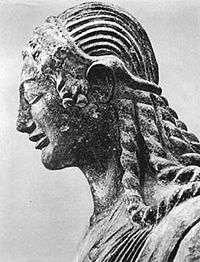Villanovan culture
 | |
| Geographical range | Europe |
|---|---|
| Period | Early Iron Age |
| Dates | c. 1100 BC – 700 BC |
| Preceded by | Proto-Villanovan culture |
| Followed by | Etruscan civilization |
| Iron Age |
|---|
| ↑ Bronze Age |
|
Ancient Near East (1200 BC – 500 BC) India (1200 BC – 200 BC) Europe (1200 BC – 1 BC)
China (600 BC – 200 BC) Korea (400 BC – 400 AD) Japan (100 BC – 300 AD) Philippines (1000 BC – 200 AD) Vietnam (1000 BC – 630 AD) Sub-Saharan Africa (1000 BC – 800 AD) |
|
Axial Age |
| ↓ Ancient history |
| Historiography |
The Villanovan culture was the earliest Iron Age culture of central and northern Italy, abruptly following the Bronze Age Terramare culture and giving way in the 7th century BC to an increasingly orientalizing culture influenced by Greek traders, which was followed without a severe break by the Etruscan civilization. The Villanovan culture and people branched from the Urnfield culture of Central Europe.[1] The Villanovans introduced iron-working to the Italian peninsula; they practiced cremation and buried the ashes of their dead in pottery urns of distinctive double-cone shape.
The name Villanovan comes from the type-site, that of the first archaeological finds relating to this advanced culture, remnants of a cemetery found near Villanova (Castenaso, 8 kilometers south-east of Bologna) in northern Italy. The excavation lasting from 1853 to 1855 was made by the scholarly owner, count Giovanni Gozzadini, and involved 193 tombs, six of which were separated from the rest as if to signify a special social status. The "well tomb" pit graves lined with stones contained funerary urns; they had been only sporadically plundered, and most were untouched. In 1893, a chance discovery unearthed another distinctive Villanovan necropolis at Verucchio, overlooking the Adriatic coastal plain.
The burial characteristics relate the Villanovan culture to the Central European Urnfield culture (c. 1300–750 BC), and Celtic Hallstatt culture (which succeeded the Urnfield culture), in such a way that it is not possible to tell them apart in their earlier stages. Cremated remains were placed in cinerary urns and then buried. A custom believed to originate with the Villanovan culture is the usage of "Hut urns", cinerary urns fashioned like small huts, and other advanced urn designs. Typical sgraffito decorations of swastikas, meanders and squares were scratched with a comb-like tool. Urns were accompanied by simple bronze fibulae, razors and rings.
Periodization
The culture is broadly divided into a Proto-Villanovan culture (Villanovan I) from c. 1100 BC to c. 900 BC and the Villanovan culture proper (Villanovan II) from c. 900 BC to c. 700 BC. This period came just before the foundation of Etruscan cities.
The later phase (Villanovan II) saw radical changes, evidence of contact with Hellenic civilization and trade with the north along the Amber Road: glass and amber necklaces on women, bronze armor and horse harness fittings, and the development of elite graves in contrast to the earlier egalitarian culture. Chamber tombs and inhumation (burial) practices were developed side-by-side with the earlier cremation practices.
Range

Generally speaking, Villanovan settlements were centered in the Adriatic Etruria, in Emilia Romagna (in particular, in Bologna and in Verucchio, near Rimini), in Marche (Fermo) and in Lazio. Further south, Villanovan cremation burials are to be found in Campania, at Capua, at the "princely tombs" of Pontecagnano near Salerno,[2] at Capo di Fiume, at Vallo di Diano and at Sala Consilina. Small scattered Villanovan settlements have left few traces other than their more permanent burial sites, which were set somewhat apart from the settlements— largely because the settlement sites were built over in Etruscan times. This site continuity encourages modern opinion generally to follow Massimo Pallottino in regarding the Villanovan culture as ancestral to the Etruscan civilization.
Issues of identity
These cultural traces may not be directly equivalent to a widespread ethnic culture that identified itself as the equivalent of "Villanovan", Renato Peroni has suggested; they tend to underlie those of both Celtic and Italic provenance, adding to the difficulties in assessing who "founded" the culture.
| Wikimedia Commons has media related to Villanovian culture. |
See also
Notes
- ↑ "Villanovan culture". Encyclopædia Britannica.
- ↑ Pontecagnano finds are conserved in the Museum of Agro Picentino.
Sources and further reading
- S. Gozzadini: La nécropole de Villanova, Fava et Garagnani, Bologna, 1870
- J. P. Mallory, "Villanovan Culture", Encyclopedia of Indo-European Culture, (Fitzroy Dearborn), 1997.
- G. Bartoloni, "The origin and diffusion of Villanovan culture." in M. Torelli, (editor) The Etruscans, pp 53–74. (Milan), 2000.
- M.E. Moser, The "Southern Villanovan" Culture of Campania, (Ann Arbor), 1982.
- D. Ridgway, "The Villanovan Cemeteries of Bologna and Pontecagnano" in Journal of Roman Archaeology 7: pp 303–16 (1994)
External links
| Wikisource has the text of the 1911 Encyclopædia Britannica article Villanova. |
- Museo Archeologico di Verucchio: Villanovan necropolis (in English)
- Ashmolean Museum: Ancient Italy Before the Romans
